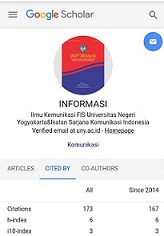PUBLIC RELATIONS AND EMPLOYEE PERFORMANCE IN NIGERIAN INSTITUTIONS OF HIGHER LEARNING
Adamkolo Mohammed Ibrahim, University of Maiduguri, Nigeria
Abstract
Organizations’ internal publics, which generally comprises two categories of personnel, namely management staff and employees constitute some of the key elements that contribute toward realizing the goals and objectives of the organization. However, unlike non-academic organizations, institutions of higher (academic) learning have two additional categories of internal publics — academic staff and students. This makes such institutions a bit unique. Public relations (PR) as a management function and tool is utilized by the management between itself and all categories of internal publics to facilitate smooth information dissemination and communication for enhanced job performance. Hence, a unique type of PR practice capable of addressing the characteristic needs of the academic staff (who are directly involved with the students) in addition to those of the non-academic staff will be required. A critically review of extant literature surrounding the impacts of the practice of PR on job performance among employees of Nigerian institutions of higher learning was performed. Additionally, critical intra-organizational PR media capable of addressing the characteristic and specific needs of the overall and specific internal publics were underscored and some policy recommendations offered. This article concludes that effective PR (a PR practice that addresses both the comprehensive and specific needs of the various classifications of internal publics) enhances job performance and productivity.
HUBUNGAN MASYARAKAT DAN KINERJA KARYAWAN DI LEMBAGA PENDIDIKAN TINGGI NIGERIA
Internal publik dalam sebuah organisasi yang pada umumnya terdiri dari dua bagian yaitu manajemen staf dan karyawan, merupakan beberapa elemen kunci yang memberikan kontribusi terhadap realisasi sasaran dan tujuan organisasi. Namun, tidak seperti organisasi non-akademik, institusi akademik memiliki dua bagian tambahan lain dalam internal publiknya – staf akademik dan siswa. Hal inilah yang kemudian membuat institusi-instistusi akademik memiliki sedikit keunikan. Public Relations (PR) sebagai fungsi manajemen digunakan oleh institusi untuk memfasilitasi penyampaian informasi dan komunikasi untuk meningkatkan performa kerja antara manajemen dan seluruh bagian publik internalnya. Oleh karena itu, PR yang memiliki keunikan seperti ini harus mampu menganalisa hal-hal apa saja yang menjadi kebutuhan staf akademik (yang secara langsung terlibat dengan siswa) dan juga staf non-akademik yang nantinya akan dibutuhkan. Sebuah tinjauan kritis menghasilkan temuan mengenai dampak praktik PR pada performa kerja para karyawan yang bekerja di institusi-institusi Nigeria. Selain itu, media intra-organisasi PR yang kritis harus mampu menganalisa karakteristik dan kebutuhan-kebutuhan tertentu dari seluruh ataupun sebagian kecil publik internal dan kebijakan-kebijakan yang ditawarkan. Penelitian ini menyimpulkan bahwa PR yang efektif (praktik PR yang menganalisa secara mendalam ataupun spesifik kebutuhan-kebutuhan berbagai kalangan yang merupakan bagian dari publik internal) dapat meningkatkan performa pekerjaan dan produktivitas.
Keywords
Full Text:
PDFReferences
Adagala, N. & Michael, B. (2017). Effective communication taking place among the internal publics in POSSS: The case of Naira County, Kenya. Journal of Communication, 1(1), 1–21.
Akinyele, S. T. (2007). A critical assessment of environmental impact on workers productivity in Nigeria. Research Journal on Business Management, 1(1), 50–61.
Akinyele S. T. (2010). The influence of work environment on workers productivity: A case study of selected oil and gas industry in Lagos, Nigeria. African Journal on Business Management, 4(3), 299–307.
Alfonso, G-H. & Suzanne, S. (2008). Crisis communications management on the web: how internet-based technologies are changing the way public relations handle business crises. Journal of Contingencies and Crisis Management, 16(3), 157–181.
https://doi.org/https://doi.org/10.1111/j.1468-5973.2008.00543.x
Austin, E. W., & Pinkleton, B. E. (2001). Strategic public relations management; planning and managing effective communication programs. Lawrence: Elbaum Associates Publishers.
Baran, S. (2010). Mass communication theory. New York: Wadsworth Learning Centre.
Brody, E. W. (2005). The brave new world of public relations: A look back. Public Relations Quarterly, 50(4), 31–34.
Bruning, S. D. & Lambe, K. E. (2008). Linking worldview, relationship attitudes, and behavioral outcomes: Implications for the study and practice of public relations. Journal of Promotion Management, 14(3 & 4), 139–151.
Cragan, J. F., & Shields, D. C. (1998). Understanding communication theory: The communicative forces for human action. Needham Heights, MA: Allyn & Bacon.
Cutlip, S., Center, A., & Broom, G. (2000). Effective public relations. (11th ed.). Englewood Cliffs, NJ: Prentice-Hall.
Falola, H. O., Oludayo, O. A., Akinnusi, D. M., Osibanjo, A. O., & Salau, O. P. (2018). Data in brief faculty commitment, effectiveness of job responsibilities and the moderating role of institutional support : A survey data set. Data in Brief, 19, 1120–1123. https://doi.org/10.1016/j.dib.2018.05.138
Grunig, J. D. & Hunt, T. (1984). Managing public relations. New York: Holt, Rinehart and Winston.
Grunig, J. E. & Grunig, L. A. (2000). Public relations in strategic management and strategic management of public relations: Theory and evidence from the IABC Excellence project. Journalism Studies, 1(2), 303–321.
Grunig, J. E. (2000). Collectivism, collaboration, and societal corporatism as core professional values in public relations. Journal of Public Relations Research, 12, 23–48.
Grunig, J. E. (2001). Two-way symmetrical public relations: Past, present, and future. In R. L. Heath (Ed.), Handbook of public relations (pp. 11–30). Oak, CA: Sage.
Grunig, J. E. (2002). The value of public relations can be found in relationships, only secondarily in reputation. Maine Magazine, 7(10), 18–22.
Grunig, J. E., Sriramesh, K., & Lyra, A. (1995). Models of public relations in an international setting, (May 2014). https://doi.org/10.1207/s1532754xjprr0703
Guth, D. W. (1995). Organizational crisis experience and public relations roles. Public Relations Review, 21(2), 123–136. https://doi.org/https://doi.org/10.1016/0363-8111(95)90003
Ifedili, C. J. (2013). Effective supervision of Nigerian university workers – A task for modern administrators. European Journal of Business and Social Sciences, 2(1), 24–32.
Igbinoba, E., Falola, H., & Osibanjo, A. (2018). Survey datasets on the influence of conflict management strategies on academic staff productivity in selected public universities in Nigeria. Data in Brief, 19, 322–325.
https://doi.org/10.1016/j.dib.2018.04.139
Johnson, E., Weaver, R., Kim, S., & Hocke, T. (2010). A quantitative review of crisis communication research in public relations from 1991 to 2009. Public Relations Review, 36(2), 190–192.
https://doi.org/10.1016/j.pubrev.2010.01.001
Kperogi, F. A. (2016, September 4). Zuckerberg, Facebook and why Hausa is a unique language. Retrieved November 11, 2018, from https://www.farooqkperogi.com/2016/09/zuckerberg-facebook-and-why-hausa-is.html
Lawal, I. & Atueyi, U. (2018, February 9). Revisiting the mandate of polytechnic education for growth. Retrieved November 11, 2018, from https://guardian-ng.cdn.ampproject.org/v/s/guardian.ng/features/education/revisiting-the-mandate-of-polytechnic-education-for-growth/
Lindeborg, R. A. (1994). Excellent communication. Public Relations Quarterly, 9, 5–11.
Macnamara, J. R. (1999). Research in public relations: A review of the use of evaluation and formative research. Asia Pacific Public Relations Journals, 1(2), 107–134.
Michnik, J. (2015). Structural analysis of problems in public relations. Multiple Criteria Decision Making, 10(105–123).
Millicent, K. A. (2013). An assessment of public relations contribution in an ICT company. A case study of RLG. New York: M.A Dissertation.
Miner, J. B. (Ed. ). (2005). Organizational behavior 1: Essential theories of motivation and leadership. London: M. E. Sharpe.
Molleda, J-C. & Alhassan, A. D. (2005). Professional views on the Nigerian Institute of Public Relations’ law and enforcement. Public Relations Review, 32, 66–68.
Ngozi, C., Malachy, E., Christy, O., Ngozi, A., & Prince, A. (2016). Role of technology inclined public relations in Federal Medical Centre, Jalingo. Mediterranean Journal of Social Sciences, 7(6), 287–298.
Ofuani, A. B., Sulaimon, A.-H. A., & Adebisi, S. A. (2018). Corporate governance practices: A comparative study of selected public corporations in Nigeria. Academic Journal of Economic Studies, 4(1), 192–202. Retrieved from http://www.ajes.ro/wp-content/uploads/AJES_article_1_161.pdf
Okwelle, P. C. & Agwi, V. I. A. (2018). Strategies for improving female students’ enrolment in technical and vocational education programs through public relations activities in Nigeria. International Journal of Advanced Academic Research, 4(1), 1–13.
Okwelle, P. C. (2010). Strategies for improving enrolment into technical teacher education programs through students’ involvement in public relations activities. Niger Delta Journal of Education, 2((1&2)), 57–63.
Osibanjo, O. A., Salau, O. P., Falola, H. O., & Oyewunmi, A. E. (2016). Workplace stress: Implications for organizational performance in a Nigerian public universities, 17(3), 261–269. https://doi.org/10.3846/btp.2016.668
Otubanjo, B. O., Amujo, O. C., & Melewar, T. C. (2010). 150 years of public relations practices in Nigeria, 1859 – 2009. Public Relations, Advertizing & Marketing Journal, 23(2), 20–31.
Paul, O. (2016). Employee relations strategy : Implication for performance in Lagos, 3(3), 53–63. https://doi.org/10.18394/iid.28545
Ritter, J. R. (2003). Behavioral finance: Department of finance. School of Business Pacific-Basin Finance Journal, 11(4), 429–437.
Sacdeva, I. S. (2009). Public relations: Principles and practices. Public relations: Principles and Practices. New Delhi: Oxford University Press.
Sadia, A., Salleh, B. M., Zulida, A. K., & Sazuliana, A. (2018). Investigating hindrance to effective communication between the management and academic staff of universities in Malaysia: A qualitative case study. International Journal of Education and Psychological Research, 7(2), 1–4.
Samuel, B. (2019). Corporate governance, Sustainability initiatives and firm performance: Theoretical and conceptual perspectives. International Journal of Asian Social Science, 9(1), 35–47.
https://doi.org/10.18488/journal.1.2019.91.35.47
Sharma, P. R. (2015). Organizational communication: Perceptions of staff members’ level of communication satisfaction and job satisfaction. Retrieved January 2, 2019, from https://dc.etsu.edu/etd/2481
Stites, J. P., & Michael, J. H. (2011). Organizational commitment in manufacturing employees: Relationships with corporate social performance. Business & Society, 50(1), 50–70.
Suchan, J. (2006). Changing organizational communication practices and norms: A framework. Journal of Business and Technical Communication, 20, 5–47.
Wiñska, J. (2010). Influence of superior-subordinate communication on employee satisfaction. Journal of Positive Management, 1(1), 110–124.
Yahaya, A. M., & Abubakar, U. I. (2017). Public relations perspectives on electoral reforms as a panacea for consolidating Nigeria’s democracy. Journal of Social and Administrative Sciences, 4(4), 45–57.
DOI: https://doi.org/10.21831/informasi.v48i2.21972
Refbacks
- There are currently no refbacks.
Copyright (c) 2019 Adamkolo Mohammed Ibrahim, Muhammad Nura Nguru
Supervised by
Our Journal has been Indexed by:
Informasi by http://journal.uny.ac.id/index.php/informasi is licensed under a Creative Commons Attribution-NonCommercial 4.0 International License.














